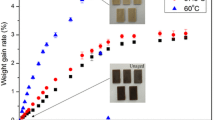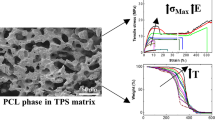Abstract
The current work aims to study the effect of jute fiber (JF) on the characteristics and performance of a thermoplastic starch/poly(lactic acid)/poly(butylene adipate-co-terephthalate) (TPS/PLA/PBAT) blend. TPS/PLA/PBAT/JF composites with a constant TPS:PLA:PBAT weight ratio of 60:30:10 and 5, 10, and 15 wt% additions of JF were fabricated using an extruder. The obtained green composites were then molded into test specimens using an injection molding machine. The TPS/PLA/PBAT/JF composites exhibited higher Young’s modulus and storage modulus but lower elongation at break and impact strength than the TPS/PLA/PBAT blend. The Young’s modulus and storage modulus of the composites significantly increased with increasing JF concentration. The crystallinity of PLA in the blend also increased with the addition of JF, while its Tg, Tcc, and Tm decreased. SEM confirmed a co-continuous phase structure of both TPS/PLA/PBAT blend and TPS/PLA/PBAT/JF composites; however, the phase size of each polymer decreased with the addition of JF. JF plays roles as a reinforcing agent, nucleating agent for PLA, and compatibility promoter between the TPS and PLA/PBAT phases. Although JF reduced thermal expansion, it retarded the biodegradation of the blend. The obtained green TPS/PLA/PBAT/JF composites have great potential as materials for biodegradable and environmentally benign injection-molded products.
Graphic abstract











Similar content being viewed by others
References
Anglès MN, Dufresne A (2000) Plasticized starch/tunicin whiskers nanocomposites. 1. Structural analysis. Macromolecules 33:8344–8353. https://doi.org/10.1021/ma0008701
Arrakhiz FZ, El Achaby M, Malha M, Bensalah MO, Fassi-Fehri O, Bouhfid R, Benmoussa K, Qaiss A (2013) Mechanical and thermal properties of natural fibers reinforced polymer composites: Doum/low density polyethylene. Mater Des 43:200–205. https://doi.org/10.1016/j.matdes.2012.06.056
Barnes HA, Hutton JF, Walters K (1989) An introduction to rheology. Elsevier, Amsterdam, pp 1–159
Beckermann GW, Pickering KL (2008) Engineering and evaluation of hemp fibre reinforced polypropylene composites: fibre treatment and matrix modification. Compos Part A Appl Sci Manuf 39:979–988. https://doi.org/10.1016/j.compositesa.2008.03.010
Bhasney SM, Bhagabati P, Kumar A, Katiyar V (2019) Morphology and crystalline characteristics of polylactic acid [PLA]/linear low density polyethylene [LLDPE]/microcrystalline cellulose [MCC] fiber composite. Compos Sci Technol 171:54–61. https://doi.org/10.1016/j.compscitech.2018.11.028
Boubekeur B, Belhaneche-Bensemra N, Massardier V (2015) Valorization of waste jute fibers in developing low-density polyethylene /poly lactic acid bio-based composites. J Reinf Plast Compos 34(8):649–661. https://doi.org/10.1177/0731684415576354
Chhabra RP (2010) Non-Newtonian fluids: an introduction. In: Deshpande AP, Krishnan JM, Kumar PBS (eds) Rheology of complex fluids. Springer, New York Dordrecht Heidelberg London, pp 3–34
Chotiprayon P, Chaisawad B, Yoksan R (2020) Thermoplastic cassava starch/poly(lactic acid) blend reinforced with coir fibres. Int J Biol Macromol 156:960–968. https://doi.org/10.1016/j.ijbiomac.2020.04.121
Das K, Ray D, Bandyopadhyay NR, Sahoo S, Mohanty AK, Misra M (2011) Physico-mechanical properties of the jute micro/nanofibril reinforced starch/polyvinyl alcohol biocomposite films. Compos B 42(3):376–381. https://doi.org/10.1016/j.compositesb.2010.12.017
Ferrarezi MMF, de Oliveira TM, Escobar da Silva LC, Gonçalves MdC (2012) Poly(ethylene glycol) as a compatibilizer for poly(lactic acid)/thermoplastic starch blends. J Polym Environ 21:151–159. https://doi.org/10.1007/s10924-012-0480-z
Ferreira WH, Carmo MMIB, Silva ALN, Andrade CT (2015) Effect of structure and viscosity of the components on some properties of starch-rich hybrid blends. Carbohydr Polym 117:988–995. https://doi.org/10.1016/j.carbpol.2014.10.018
Friedrich K (1989) Chapter 11—Fractographic analysis of polymer composites. In: Friedrich K (ed) Composite materials series volume 6 application of fracture mechanics to composite materials. Elsevier, Amsterdam, pp 425–487
Gamon G, Evon P, Rigal L (2013) Twin-screw extrusion impact on natural fibre morphology and material properties in poly(lactic acid) based biocomposites. Ind Crops Prod 46:173–185. https://doi.org/10.1016/j.indcrop.2013.01.026
Gironès J, López JP, Mutjé P, Carvalho AJF, Curvelo AAS, Vilaseca F (2012) Natural fiber-reinforced thermoplastic starch composites obtained by melt processing. Compos Sci Technol 72(7):858–863. https://doi.org/10.1016/j.compscitech.2012.02.019
Greenhalgh ES (2009) Failure analysis and fractography of polymer composites. CRC Press LLC, New York USA
Ishiaku US, Yang XY, Leong YW, Hamada H, Semba T, Kitagawa K (2007) Effects of fiber content and alkali treatment on the mechanical and morphological properties of poly(lactic acid)/poly(caprolactone) blend jute fiber-filled biodegradable composites. J Biobased Mater Bioenergy 1:78–86. https://doi.org/10.1166/jbmb.2007.009
Jian J, Xiangbin Z, Xianbo H (2020) An overview on synthesis, properties and applications of poly(butylene-adipate-co-terephthalate)–PBAT. Adv Ind Eng Polym Res 3(1):19–26. https://doi.org/10.1016/j.aiepr.2020.01.001
Jullanun P, Yoksan R (2020) Morphological characteristics and properties of TPS/PLA/cassava pulp biocomposites. Polym Test 88:106522. https://doi.org/10.1016/j.polymertesting.2020.106522
Kaewtatip K, Tanrattanakul V (2012) Structure and properties of pregelatinized cassava starch/kaolin composites. Mater Des 37:423–428. https://doi.org/10.1016/j.matdes.2011.12.039
Kelnar I, Fortelný I, Kaprálková L, Kratochvíl J, Angelov B, Nevoralová M (2016) Effect of layered silicates on fibril formation and properties of PCL/PLA microfibrillar composites. J Appl Polym Sci 133(8):43061. https://doi.org/10.1002/app.43061
Kumar S, Varma IK (2007) Degradation studies of thermoplastics composites of jute fiber–reinforced LDPE/polycaprolactone blends. Polym-Plast Technol Eng 45(11):1219–1225. https://doi.org/10.1080/03602550600887566
Li H, Huneault MA (2011) Comparison of sorbitol and glycerol as plasticizers for thermoplastic starch in TPS/PLA blends. J Appl Polym Sci 119(4):2439–2448. https://doi.org/10.1002/app.32956
Lim LT, Auras R, Rubino M (2008) Processing technologies for poly(lactic acid). Prog Polym Sci 33(8):820–852. https://doi.org/10.1016/j.progpolymsci.2008.05.004
Lomeli-Ramirez MG, Kestur SG, Manriquez-Gonzalez R, Iwakiri S, de Muniz GB, Flores-Sahagun TS (2014) Bio-composites of cassava starch-green coconut fiber: part II-structure and properties. Carbohydr Polym 102:576–583. https://doi.org/10.1016/j.carbpol.2013.11.020
Manepalli PH, Alavi S (2019) Mathematical modeling of mechanical and barrier properties of poly(lactic acid)/poly(butylene adipate-co-terephthalate)/thermoplastic starch based nanocomposites. J Food Eng 261:60–65. https://doi.org/10.1016/j.jfoodeng.2019.04.004
Mathew AP, Oksman K, Sain M (2005) Mechanical properties of biodegradable composites from poly lactic acid (PLA) and microcrystalline cellulose (MCC). J Appl Polym Sci 97(5):2014–2025. https://doi.org/10.1002/app.21779
Mather AB, Bhardwaj IS (2003) Testing and evaluation of plastics. Allied Publishers PVT Limited, New Delhi India
Matta AK, Rao RU, Suman KNS, Rambabu V (2014) Preparation and characterization of biodegradable PLA/PCL polymeric blends. Procedia Mater Sci 6:1266–1270. https://doi.org/10.1016/j.mspro.2014.07.201
Mohanty S, Nayak SK (2012) Biodegradable nanocomposites of poly(butylene adipate-co-terephthalate) (PBAT) and organically modified layered silicates. J Polym Environ 20:195–207. https://doi.org/10.1007/s10924-011-0408-z
Nagarajan V, Mohanty AK, Misra M (2013) Sustainable green composites: value addition to agricultural residues and perennial grasses. ACS Sustain Chem Eng 1:325–333. https://doi.org/10.1021/sc300084z
Nam TH, Ogihara S, Kobayashi S (2012) Interfacial, mechanical and thermal properties of coir fiber-reinforced poly(lactic acid) biodegradable composites. Adv Compos Mater 21(1):103–122. https://doi.org/10.1163/1568112X629540
Ning N, Fu S, Zhang W, Chen F, Wang K, Deng H, Zhang Q, Fu Q (2012) Realizing the enhancement of interfacial interaction in semicrystalline polymer/filler composites via interfacial crystallization. Prog Polym Sci 37(10):1425–1455. https://doi.org/10.1016/j.progpolymsci.2011.12.005
Nuzzo A, Coiai S, Carroccio SC, Dintcheva NT, Gambarotti C, Filippone G (2014) Heat-resistant fully bio-based nanocomposite blends based on poly(lactic acid). Macromol Mater Eng 299(1):31–40. https://doi.org/10.1002/mame.201300051
Phetwarotai W, Aht-Ong D (2013) Characterization and properties of nucleated polylactide, poly(butylene adipate-co-terephthalate), and thermoplastic starch ternary blend films: effects of compatibilizer and starch. Adv Mat Res 747:673–677. https://doi.org/10.4028/www.scientific.net/AMR.747.673
Plackett D, Andersen TL, Pedersen WB, Nielsen L (2003) Biodegradable composites based on l-polylactide and jute fibres. Compos Sci Technol 63(9):1287–1296. https://doi.org/10.1016/S0266-3538(03)00100-3
Polychronopoulos ND, Vlachopoulos J (2018) Polymer processing and rheology. In: Jafar Mazumder MA, Sheardown H, Al-Ahmed A (eds) Functional polymers. Springer, Cham, pp 1–47. https://doi.org/10.1007/978-3-319-92067-2_4-1
Prachayawarakorn J, Chaiwatyothin S, Mueangta S, Hanchana A (2013) Effect of jute and kapok fibers on properties of thermoplastic cassava starch composites. Mater Des 47:309–315. https://doi.org/10.1016/j.matdes.2012.12.012
Raghu N, Kale A, Raj A, Aggarwal P, Chauhan S (2018) Mechanical and thermal properties of wood fibers reinforced poly(lactic acid)/thermoplasticized starch composites. J Appl Polym Sci 135(15):46118. https://doi.org/10.1002/app.46118
Ray D, Sarkar BK, Basak RK, Rana AK (2004) Thermal behavior of vinyl ester resin matrix composites reinforced with alkali-treated jute fibers. J Appl Polym Sci 94(1):123–129. https://doi.org/10.1002/app.20754
Ren J, Fu H, Ren T, Yuan W (2009) Preparation, characterization and properties of binary and ternary blends with thermoplastic starch, poly(lactic acid) and poly(butylene adipate-co-terephthalate). Carbohydr Polym 77(3):576–582. https://doi.org/10.1016/j.carbpol.2009.01.024
Scaffaro R, Maio A, Lopresti F (2018) Physical properties of green composites based on poly-lactic acid or Mater-Bi® filled with Posidonia Oceanica leaves. Compos Part A Appl Sci Manuf 112:315–327. https://doi.org/10.1016/j.compositesa.2018.06.024
Shirai MA, Olivato JB, Garcia PS, Müller CMO, Grossmann MVE, Yamashita F (2013) Thermoplastic starch/polyester films: effects of extrusion process and poly(lactic acid) addition. Mater Sci Eng C 33(7):4112–4117. https://doi.org/10.1016/j.msec.2013.05.054
Singh H, Singh JIP, Singh S, Dhawan V, Tiwari SK (2018) A brief review of jute fibre and its composites. Mater Today Proc 5(14):28427–28437. https://doi.org/10.1016/j.matpr.2018.10.129
Sue H-J, Wang S, Jane J-L (1997) Morphology and mechanical behaviour of engineering soy plastics. Polymer 38(20):5035–5040. https://doi.org/10.1016/S0032-3861(97)00048-7
Tachaphiboonsap S, Jarukumjorn K (2014) Mechanical, thermal, and morphological properties of thermoplastic starch/poly(lactic acid/poly(butylene adipate-co-terephthalate) blends. Adv Mater Res 970:312–316. https://doi.org/10.4028/www.scientific.net/AMR.970.312
Teixeira EdM, Pasquini D, Curvelo AAS, Corradini E, Belgacem MN, Dufresne A (2009) Cassava bagasse cellulose nanofibrils reinforced thermoplastic cassava starch. Carbohydr Polym 78(3):422–431. https://doi.org/10.1016/j.carbpol.2009.04.034
Teixeira EdM, Curvelo AAS, Corrêa AC, Marconcini JM, Glenn GM, Mattoso LHC (2012) Properties of thermoplastic starch from cassava bagasse and cassava starch and their blends with poly(lactic acid). Ind Crops Prod 37(1):61–68. https://doi.org/10.1016/j.indcrop.2011.11.036
Wang N, Yu J, Ma X (2007) Preparation and characterization of thermoplastic starch/PLA blends by one-step reactive extrusion. Polym Int 56(11):1440–1447. https://doi.org/10.1002/pi.2302
Wang P, Chen F, Zhang H, Meng W, Sun Y, Liu C (2017) Large-scale preparation of jute-fiber-reinforced starch-based composites with high mechanical strength and optimized biodegradability. Starch-Stärke 69(11–12):1700052. https://doi.org/10.1002/star.201700052
Zhang J, Mungara P, Jane J (2001) Mechanical and thermal properties of extruded soy protein sheets. Polymer 42:2569–2578. https://doi.org/10.1016/S0032-3861(00)00624-8
Acknowledgements
This research was financially supported by the Thailand Research Fund (TRF) and Mitrman Marketing & Engineering Co., Ltd., Thailand through the Research and Researchers for Industry Program [PHD57I0073]. The authors are also grateful to Park Chong Jute Mill Co., Ltd. (Thailand) for providing jute fiber, and to Mettler-Toledo Ltd. (Thailand) for the use of its DSC analyzer.
Author information
Authors and Affiliations
Contributions
Chanakorn Yokesahachart: Validation, Formal analysis, Investigation, Data curation, Writing-Original draft, Visualization. Rangrong Yoksan: Conceptualization, Methodology, Resources, Data curation, Writing-review and editing, Visualization, Supervision, Project administration, Funding acquisition. Nattaporn Khanoonkon: Formal analysis, Investigation. Amar Kumar Mohanty: Resources, Supervision. Manjusri Misra: Supervision.
Corresponding author
Ethics declarations
Conflict of interest
The authors declare that they have no conflicts of interest.
Ethical approval
The article does not include human participants and/or animals research.
Additional information
Publisher's Note
Springer Nature remains neutral with regard to jurisdictional claims in published maps and institutional affiliations.
Supplementary Information
Below is the link to the electronic supplementary material.
Rights and permissions
About this article
Cite this article
Yokesahachart, C., Yoksan, R., Khanoonkon, N. et al. Effect of jute fibers on morphological characteristics and properties of thermoplastic starch/biodegradable polyester blend. Cellulose 28, 5513–5530 (2021). https://doi.org/10.1007/s10570-021-03921-8
Received:
Accepted:
Published:
Issue Date:
DOI: https://doi.org/10.1007/s10570-021-03921-8




